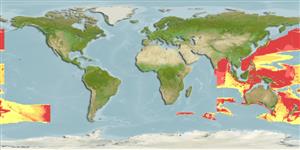>
Myctophiformes (Lanternfishes) >
Myctophidae (Lanternfishes) > Diaphinae
Etymology: Diaphus: Greek, dis, dia = through + Greek, physa, phyo = to beget, to have as offspring (Ref. 45335).
More on author: Weber.
Environment: milieu / climate zone / depth range / distribution range
Ekologi
laut; kisaran kedalaman 387 - 1537 m (Ref. 27311). Deep-water
Indo-West Pacific: widely distributed in the region. South China Sea and East China Sea (Ref.74511).
Size / Weight / umur
Maturity: Lm ? range ? - ? cm
Max length : 7.3 cm SL jantan/; (Ref. 44036)
Lipid content is 7.9 % in fresh body weight and wax ester is 3.7 % in total lipids (Ref. 9193).
Life cycle and mating behavior
Kematangan | Reproduksi, perkembang biakan | Pemijahan | telur-telur | Fecundity | Larva
Masuda, H., K. Amaoka, C. Araga, T. Uyeno and T. Yoshino, 1984. The fishes of the Japanese Archipelago. Vol. 1. Tokai University Press, Tokyo, Japan. 437 p. (text). (Ref. 559)
Status IUCN Red List (Ref. 130435)
ancaman kepada manusia
Harmless
penggunaan manusia
informasi lanjut
AcuanBudidaya airprofil budidaya airStrainGenetikaElectrophoresesDiturunkanPenyakit-penyakitPengolahanNutrientsMass conversion
mitraGambarStamps, Coins Misc.Suara-suaraCiguateraKecepatanTipe renangArea insangOtolithsOtakPenglihatan / visi
Alat, peralatan
laporan khas
muat turun XML
Sumber internet
Estimates based on models
Preferred temperature (Ref.
123201): 2.2 - 8.9, mean 6.3 °C (based on 612 cells).
Phylogenetic diversity index (Ref.
82804): PD
50 = 0.5000 [Uniqueness, from 0.5 = low to 2.0 = high].
Bayesian length-weight: a=0.00759 (0.00332 - 0.01733), b=3.02 (2.83 - 3.21), in cm total length, based on LWR estimates for this Genus-body shape (Ref.
93245).
Trophic level (Ref.
69278): 3.1 ±0.3 se; based on size and trophs of closest relatives
Generation time: 0.9 ( na - na) years. Estimated as median ln(3)/K based on 1
growth studies.
Daya lenting (Ref.
120179): Tinggi, Waktu penggandaan populasi minimum kurang dari 15 bulan (tmax=2.5).
Fishing Vulnerability (Ref.
59153): Low vulnerability (12 of 100).
Nutrients (Ref.
124155): Calcium = 129 [45, 365] mg/100g; Iron = 1.08 [0.42, 2.90] mg/100g; Protein = 16.1 [14.0, 18.1] %; Omega3 = 1.09 [0.51, 2.32] g/100g; Selenium = 16.2 [4.8, 53.0] μg/100g; VitaminA = 31.4 [5.5, 202.3] μg/100g; Zinc = 0.806 [0.459, 1.440] mg/100g (wet weight); based on
nutrient studies. 